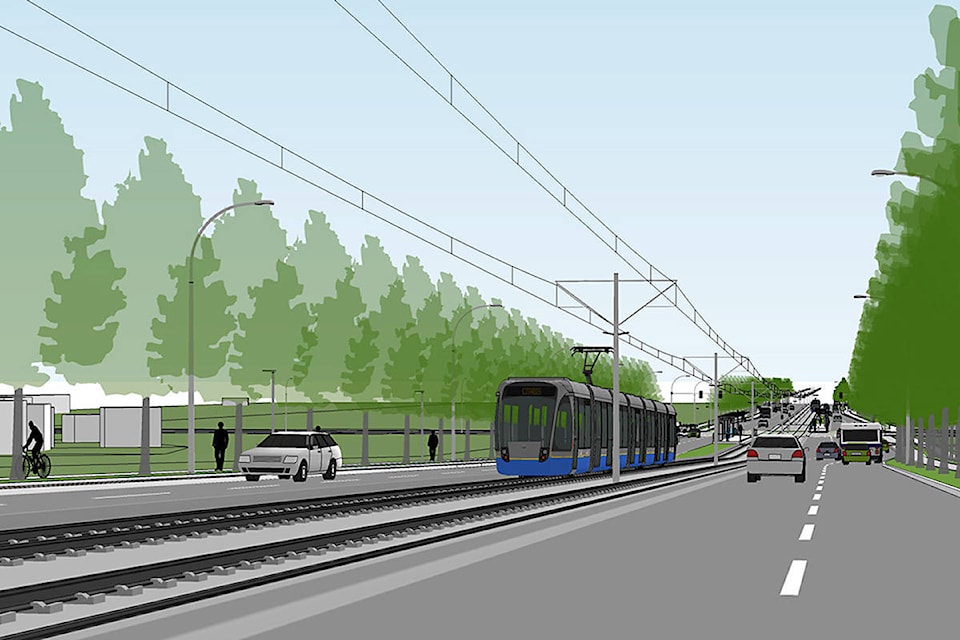When the first rapid transit train to connect Langley City to Surrey and the rest of the Lower Mainland arrives, about a decade from now, it will be a different Langley City in many respects, one that has made changes to best take advantage of the unique opportunity the new service represents.
That is the goal of the new vision strategy, “Langley City: Nexus of Community”, which has been unanimously adopted by council.
The word Nexus was chosen to describe Langley City, as “a portal between two worlds,” Fraser Valley and Metro Vancouver.
The goal of the strategy is to make the city a “key destination” on the new rail transit line and “a desired place to live for people of all ages and family units.”
A long list of changes to achieve that goal are outlined in two documents, Langley City: Nexus of Community and Langley City Vision: Recommendations and Implementation Report. Both can be downloaded from the Langley City website.
The product of extensive research and workshops, the vision strategy aims to avoid the mistake other municipalities have made by failing to get ready for rapid transit’s arrival.
The Nexus documents notes communities that fail to plan ahead for rapid transit haven’t done so well.
One section points to the history of early SkyTrain development in Vancouver and New Westminster.
The Cambie Corridor planning is described as “reactionary rather than proactive as it took place well after construction of the Canada Line.”
Redevelopment along the Expo Line has been “highly variable … over 30 years, zero redevelopment has taken place within walking distance of the 22nd Street Station while massive redevelopment has taken place around the New Westminster Station in the same city.”
The wide-ranging Nexus strategy aims to avoid that fate with a “made in Langley” approach with updated regulations governing housing to encourage a bigger range of residential types in advance of rapid transit, and pre-planned projects to complement the arrival of the train.
Some of the specific proposals include making the train station planned for 203 Street more than a transportation station, with mixed-use development that forms a community hub.
It also calls for a performing arts centre described as “a cultural/entertainment facility, including a range of performance spaces”, a variety of special events, “held frequently and throughout the year,” restaurants with “unique and diverse menus,” “niche/destination retail shops like butchers, cheese shops “and other shops for products you just don’t buy on-line, and an improved night life.
READ MORE: Metro Van mayors move forward with transportation plan with hopes of curing congestion
“Rapid transit is coming to Langley City in the next decade and we want to be ready.” said Mayor Ted Schaffer.
“We want to drive that change.”
The strategy is the product of past consultations, demographic and development research and two workshops with participants, including Mayor and Council and experts and leaders in areas like city planning, place-making, sustainability, architecture, politics, recreation and wellness, education, technology and lifestyle.
“We can become a magnet that attracts people based on our cornerstones of community, connection, experiences and integration” Schaffer said.
The City strategy has been developed in response to a commitment from three levels of government to fund a new rapid transit extension to the City—a new B-Line express bus service in 2019 and fixed rail by 2028.
“We have a unique opportunity to capitalize on the new fixed rail rapid transit line that is coming to Langley City,” said City Chief Administrative Officer Francis Cheung.
The Nexus documents describe a future Langley City with a variety of new mixed-use developments that offer a diversity of housing, community services and business opportunities for residents.
It says visitors to the future Langley City will see “wine bars, craft breweries, coffee shops,specialty bakeries, food from around the world—as you walk through town you will see buskers in the centre square, children playing and dancing to the music, seniors playing cards in the shade.
Over at the arts centre you can catch a show and during intermission you admire the graduate art display in the lobby from the local university.
Downtown will be vibrant and bustling with shoppers and revelers, day and night; and entertainment will reflect our people and nature.”
While the documents acknowledge the city has issues - small size, aging housing stock, householder incomes that lag behind other South Fraser municipalities, it says the municipality ’s “current assets are well positioned to be in greater demand a decade from now.”
“The City has ‘good bones’. It is a compact municipality with an efficient infrastructure network, a distinct and walkable downtown, significant commercial and industrial sectors and a residential sector with substantial single family and multi-family development.”
dan.ferguson@langleytimes.com
Like us on Facebook and follow us on Twitter
